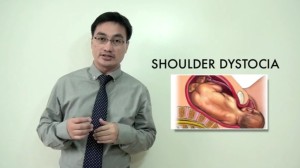An exclusive production by the Sarawak General Hospital O&G Department on how to systematically manage shoulder dystocia.
Presented by Dr Sukanda B.Jaili
Edited by Dr Lim Geng Yan
Advised by Dr Harris Suharjono
– Risk Factors :
- Previous History
- Poorly controlled DM
- Cephalo-pelvic Disproportion
- Big Baby
- Instrumental deliveries
– Clinical Signs :
- Secondary Arrest
- Prolonged 2nd Stage
- Turtle Sign: Head of fetus appears with mother’s pushing and uterus contraction; and retracts back when pushing stops.
– Our Goal :
- Demonstrate proper technique.
- Systematic approach to shoulder dystocia.
– Step-by-step management guide :
- Call for help immediately : please remember to also inform a pediatrician or a MO/HO from the pediatric team.
- Perform/Extend Episiotomy. After calling for help and performing episiotomy, you must STOP MOTHER FROM PUSHING to avoid further injury to fetus and causing further obstruction.
- Put in McRobert’s position. Hyperextension & Abduction of hip; Flexion of knee. In 90% of the cases, baby is delivered after putting mother in McRobert’s position.
- Apply suprapubic pressure. Press on posterior part of anterior shoulder, NOT in a downward motion. This maneuver is performed by an assistant, NOT the person conducting the delivery. McRobert’s position and suprapubic pressure should be performed simultaneously.
- Woods’ screw maneuver. Press on posterior part of anterior shoulder, and press on anterior part of posterior shoulder. Pressure applied simultaneously. Dislodge anterior shoulder laterally.
- Delivery of posterior shoulder. Follow posterior shoulder till level of elbow, facilitate flexion by pressing cubital fossa, follow range of movement of hand to chest and face of baby, deliver posterior shoulder. Anterior shoulder dislodged by rotating to posterior.
- Put in roll over position. Put mother on all fours.
- Repeat above procedures until baby is delivered.
Zavaneli Maneuver: Baby pushed back into uterus delivered via caesarean section.
For demised fetus:
- Symphysiotomy
- Clavicular fracture.
After delivery of baby and placenta, inspect vagina and perineum to rule out genital tract injury.
Our AIM: delivery within 10 minutes.


